How WandaVision Captures The Stages Of Grief – Marvel At It’s Most Introspective
WandaVision, one of the most innovative concepts taken on by the MCU in its history, recently came to an end after its nine-episode run. While the series was considered a delight for most, others weren’t so happy with its finish line and how it helped the MCU’s future take flight. However, pretty much everybody can agree on one thing, and that’s how the show manages to navigate topics of trauma, grief, and love. In this analysis of WandaVision, we’ll reflect on how it captures the different stages of grief, all while highlighting how it perfectly plays into the character design of Wanda Maximoff.
Readers beware; this post will spoil the entirety of the show. Not caught up on the ending? Read our recap of the WandaVision finale for a full summary.
WandaVision Captures The Stages of Grief Effortlessly and Distractingly
Wanda Maximoff has, to put it lightly, been through some stuff. She witnessed the tragic death of both of her parents as a young girl, only to later lose her brother. After finally learning how to process some of her past, Wanda falls in love with Vision, a synthezoid powered by the Mind Stone. But just as things are looking toward a future filled with love, Thanos takes it all away from her. She goes from hopeful to hopeless in mere moments and loses her footing.
Losing your family and beloved is enough to wreck just about anybody. Yet for Wanda, a woman with immense abilities (including energy manipulation and telekinesis, among others), this kind of emotional turmoil cuts deeper. Motivated by nothing but pain, Wanda unleashes enough of her hurt to put an entire town, Westview, under her grieving abyss.
At first glance, the series tells the tale of somebody who is too dysfunctional after losing somebody that she imagines false realities. But upon a deeper reflection, WandaVision actually goes through the stages of grief in a genius way.
Grief was initially divided into five unique stages by Elizabeth Kübler-Ross in 1969. This model has been used for helping people deal with their grief, among encouraging the acceptance of it in others. Let’s take a look at how this works for Wanda.
 Image via Marvel Studios/Disney+.
Image via Marvel Studios/Disney+.
Stage One: Denial
Denial is one of the strongest defense mechanisms on Earth-616. By pretending that a terrible event or impending upset isn’t happening, our minds can numb themselves from the pain. Unfortunately, denying and numbing the truth prevents you from healing and learning how to move forwards.
The first handful of episodes of WandaVision perfectly showcase somebody in the stage of denial. The first episode has Wanda say a line that mentions her husband and his “indestructible head.” Those who watched Avengers: Infinity War know that having the Mind Stone ripped from Vision’s head is how he perished. So, Wanda denies that such an event ever happened. How could he be killed if his head is so indestructible?
The entirety of Westview can be seen as a form of denial. Wanda refuses to accept a world in which Vision is not in it and is willing to go to lengths to create one where he is.
 Image via Marvel Entertainment/Disney+
Image via Marvel Entertainment/Disney+
Stage Two: Anger
We all know what anger is. It’s the emotion we feel when things don’t go our way, and we are helplessly frustrated. Or what is felt when somebody does something that we deem unfair. Ultimately, anger is one of the easiest emotions to feel. It requires little introspection and processing. It’s just pure, raw emotion.
Wanda tries her best to contain her non-positive emotions when wrapped up in her sitcom world of Westview. Though, any time that she is snapped out of it, we see her rage. The first instance of this is when Geraldine, who is later revealed as Captain Monica Rambeau, mentions the death of her brother, Pietro. She is angry enough by the truth that she casts Geraldine/Monica out of the Hex by using her strength and powers.
Later, Wanda exits the Hex to confront S.W.O.R.D. Agents who send a drone inside of Westview. She is angry enough to threaten them with her abilities, and we believe these warnings.
As time goes forward, it’s clear that Wanda is willing to express her anger on anybody who dares to pose a risk to the perfect world that she has created.
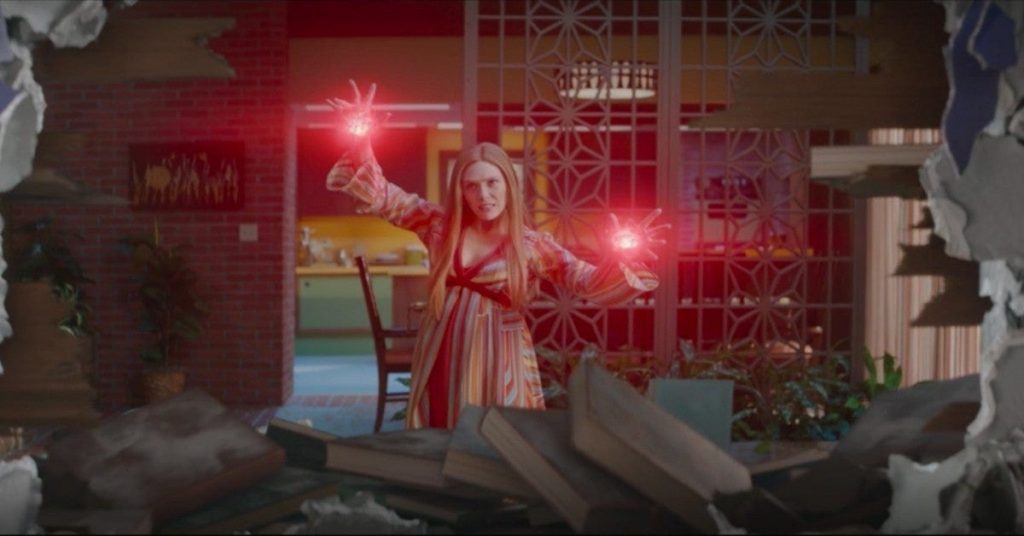 Image via Marvel Entertainment/Disney+.
Image via Marvel Entertainment/Disney+.
Stage Three: Bargaining
Bargaining is all about control. Nobody wants to feel grief. Beyond how it rips away pieces of our lives, grief reminds us that we have little power in this world. For a woman as powerful as Wanda, who is used to having plenty of control, bargaining means that she is doing anything that she can to feel like she has a handle on the reality in front of her.
Westview isn’t just about denial. Once we realize that Wanda has some sense of awareness over what is happening, especially as she starts to remember the pieces that lead to the town’s creation, we see it more as a bargaining tool. Wanda knows deep inside that Vision cannot exist outside of the Hex. Westview helps her accept this. That is, on one condition: that the Hex remains.
Another excellent example of Wanda’s bargaining comes with the arrival of her “brother”, Pietro, a.k.a. Fietro. A man arrives at her doorstep, claiming to be her brother. He does not look at all like she remembers. Despite all instincts telling her that something is off, she’s willing to accept it as a bargain. She can’t have her real brother, but she can have Evan Peters. Could this be enough? Sure, for a little while. Take a look at a conversation between Kevin Smith and series director Matt Shakman below as they discuss this stage’s complexities.
Bargaining helps to postpone the pain that you know you’ll feel if you move forward. Wanda is willing to bargain with so much energy that she allows others to suffer for it. This is seen throughout the entirety of the series, including in the finale. The citizens of Westview are hurting, right alongside Wanda, but she’s willing to let them. It’s only when she pushes past the fifth stage that she can let them go.
Stage Four: Depression
Depression is a state that many of us are familiar with. When somebody is in such an extreme state of sadness, they’re unable to feel joy or live your life as you would prior to its onset. This stage is what people often match up with the feeling of grief in their minds. It is the unbearable sadness that comes with understanding what has occurred.
This stage is best seen in the seventh episode of WandaVision, in “Breaking the Fourth Wall.” The episode, which plays on 2000s sitcoms, shows Wanda having a day to herself. She struggles to get out of bed and wants nothing but to mop around. Spending time with her children or Vision isn’t her priority. Being left alone with her emotions is.
Depression is hard. While it may seem like somebody in this stage may never push forward, it remains a stage that shows progress. When you’re in this stage, you’re willing to accept what has happened, and what has been lost. As rough as it may be, it’s a sign that you can eventually understand that life goes on, even after unbearable pain.
 Image via Marvel Entertainment/Disney+.
Image via Marvel Entertainment/Disney+.
Stage Five: Acceptance, The Finale of the Stages of Grief in WandaVision
Acceptance, the final stage, is one that can take time to get to. And not everybody going through grief will get there if they’re not given the supports and resources needed. This stage is not one of joy or complete understanding, but rather one where you can move forward in your life and accept that you have gone through something traumatic.
It takes Wanda a long time to get to the stage of acceptance. Nine episodes, to be exact. There are even moments when we’re not sure that she’ll get there at all. In the series finale, Wanda can say goodbye to her children and Vision, giving them up for the safety of the citizens of Westview. Wanda knows that she may never see them again, even if it’s not completely impossible. And finally, she can live with this understanding. It’s going to hurt her like Hell, but she does it.
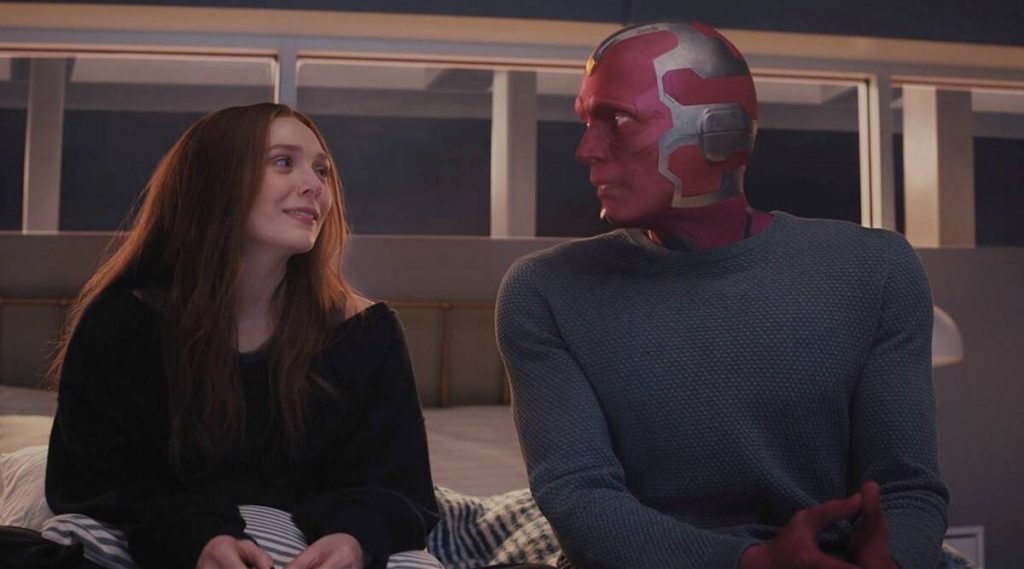 Image via Marvel Entertainment/Disney+.
Image via Marvel Entertainment/Disney+.
WandaVision And Westview Help Wanda Pass Through The Stages of Grief
Over the course of an entire series, WandaVision gives Wanda the space that she needs to go through all five stages of grief. We’re given a neat and exciting show, but the character deals with something sincere and heartbreaking. While we don’t condone taking over an entire town for the sake of personal recovery, we understand that the creation of the Hex was designed to help Wanda heal.
The events that occur through the series show Wanda Maximoff what it means to truly love. Learning these things through the relationship that she develops with her children, her life partner, and a few friends made along the way teach Wanda a sense of normalcy. This is something that she never had the opportunity to experience while growing up. Learning how to love somebody under these false circumstances teaches her what it truly means to grieve. After all, as Vision puts it so eloquently, what is grief if not love persevering?
 Image via Marvel Entertainment/Disney+.
Image via Marvel Entertainment/Disney+.
What WandaVision Teaches Us About Unloading Our Trauma Onto Others
Wanda isn’t always a hero. For many people, and especially the people of Westview, she is a cold-hearted villain. She allows hundreds of residents of the town to suffer under her mind control for a prolonged period of time. They are willing to beg for their death to escape the hurt. We know why Wanda is doing this, but they don’t understand it. And even if they did, there is no reason for them to magically become okay with it.
Wanda taking control over the minds of these people teaches us an all too important lesson about coping with trauma and navigating grief: your actions remain your responsibility. You can be hurting more than anybody has ever hurt before, but that doesn’t absolve you of your responsibility to think about others.
None of us would create a Hex around a town and imprison people just to deal with our own trauma. And that’s because we don’t live in a cinematic universe. But people do react in various ways in their response to grief, and sometimes it hurts other people. Trauma and grief might explain our actions, but it doesn’t excuse them. Watching WandaVison is a good reminder of that.
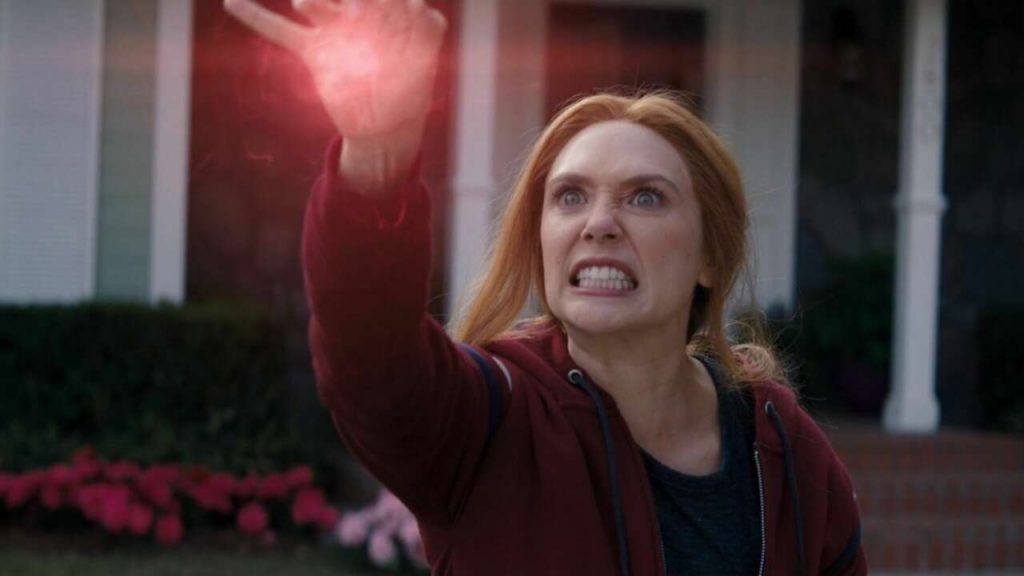 Image via Marvel Entertainment/Disney+.
Image via Marvel Entertainment/Disney+.
The 5 Stages of Grief in WandaVision Remind Us That Heroes Are People, Too
Movies about superheroes and villains are great at giving us people to look up to. We see them with their abnormal levels of strength and think of them as flawless, all-mighty beings. Plenty of Marvel properties exist to excite us or to thrill us with these powers. But WandaVision is different. It breaks down normal human reactions and reminds us of the intimacy of loss, love, and aching.
Not everybody who is grieving will pass through the five stages of grief. After all, losing somebody isn’t a one-size-fits-all experience. If you’ve gone through something traumatic or have lost someone, reach out to a doctor or trusted loved one to see how you can get the supports that you need. Asking for help is the biggest sign of a superhero that we can think of.
The MCU is filled with heroic action and impressive fighting. But WandaVision shows a woman going through the stages of grief, feeling more human than we’ve ever seen a hero. And for that, we applaud Marvel for giving us something to latch onto.
Featured image via Marvel Entertainment/Disney+.
Meghan Hale is the kind of movie lover that has a "must watch" that is a mile long... and growing. When she isn't talking about the latest film and television news she is writing one of her many in-process novels, screaming film trivia at anybody who will listen, and working as a mental health care professional. Follow her on Twitter @meghanrhale for some fun theories and live reactions to all things entertainment.

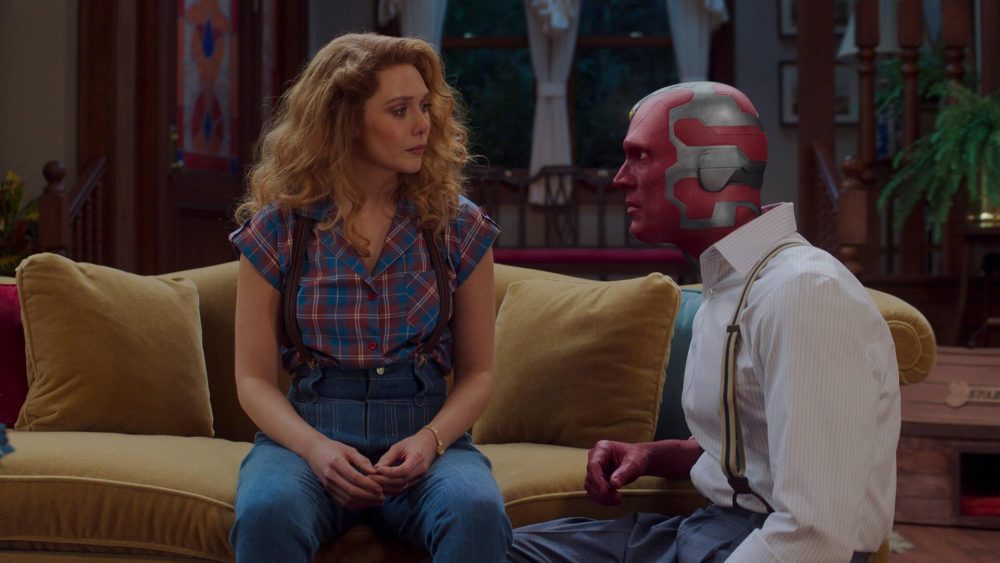

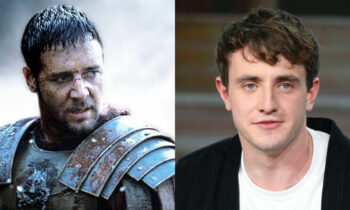





Leave a comment